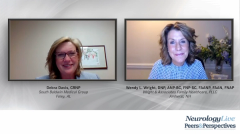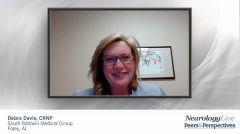
Common Sleep Disorders and Their Impact on Quality of Life
Advanced practice practitioners discuss different types of sleep disorders in the general population and their impact on quality of life.
Episodes in this series

Wendy L. Wright, DNP, ANP-BC, FNP-BC, FAANP, FAAN, FNAP: As you’re seeing patients with sleep and you’re going through those differentials in your head as we all do, there are other causes of sleep issues rather than just plain old insomnia. Are you seeing things like I am, for instance, other types of sleep disorders such as restless leg syndrome or—I know we all read about narcolepsy. I do think we have 1 patient in our clinic with narcolepsy—for me, what I see a lot of is obstructive sleep apnea.
Debra Davis, CRNP: I do, too. I know you can’t tell through the screen, but I’m over 6 feet tall. And I used to explain to my patients what a Mallampati score is. A Mallampati score is a score of 1 to 4 where you look down someone’s throat and you see how much room they have there. And I used to tell my patients all the time: “Look at me. Somebody like me, I’ll never have sleep apnea. My Mallampati score is 1, I’m tall, I’m long.” And then my dentist said, “listen, when I put you to sleep, your jaw falls back, and you actually have a problem with breathing.” And I just didn’t even believe him. I thought that was wrong. So, I did a home sleep study, which we’ll discuss later and my oxygen saturation went down to 77. And it really opened a whole new world for me, because I thought, “oh my, if I can have it” and then I can point to people on the street who have it.
You look at somebody with an 18-inch neck, and their neck is small, and you just know that they’ve got sleep apnea. So I do always ask: “Do you snore? Has anyone told you that you snored? Do you get kicked out of the bed at night by your partner? Do you wake up gasping for air? Do you wake up with a headache? Have you not had enough oxygen to your brain to where you wake up with a headache?” And for me, it’s always, too, that afternoon lull. “Do you need something after lunch to keep you awake?” And what I find is people are not really realizing how tired they are and that they could feel better. And that was what happened with me was after the first night I slept with my sleep apnea machine, I was like, so this is what it feels like for your brain to be awake. It was very different. And so, it just opened this world to me of where I want to diagnose everybody with sleep apnea. Not really, but I want them to feel better. I really do want to be more and am more. I look at everybody’s Mallampati score.
Wendy L. Wright, DNP, ANP-BC, FNP-BC, FAANP, FAAN, FNAP: That’s so great. One of the things we did in our clinic we were among the first nurse practitioner clinics in the nation to introduce home sleep studies into primary care. When people are telling me that they’re waking up, they’re gasping, that their spouses moved out of the bedroom, we’re able to get them hooked up to a home sleep study that day. They just sleep, bring it back the next day, we send the data out to the lab and we know in 3 days if someone has obstructive sleep apnea. I think that you brought up a really good point about it because we’re also used to looking at people and saying, that person likely has it. But you brought up the point that you cannot pigeonhole a particular group because people that are really thin can have sleep apnea as well. So we have to ask those questions.
Debra Davis, CRNP: Absolutely.
Wendy L. Wright, DNP, ANP-BC, FNP-BC, FAANP, FAAN, FNAP: You brought up a point about people not realizing how badly they feel. I saw a patient today and he said: “I’ve reached the highest weight I’ve ever reached in my life, and I have to tell you, I am snoring. I could wake up the entire house.” But he said: “What really brought me in to see you today is that I now have to stop at a traffic light. And when I stop there, I’m worried that I’m going to fall asleep. That I have to often pull over.” Do you think people fully understand the impact of sleep on the quality of their lives?
Debra Davis, CRNP: I don’t think they realize how it impacts them, and I don’t think they realize how it impacts others. We have another nurse practitioner at our clinic. And if she doesn’t sleep well, the next day the staff knows about it. And you find that in people, they’ll be snappy at other folks when they wouldn’t normally act that way. And for someone to fall asleep at a stoplight, that is just so scary, because what if it gets worse and they fall asleep while they’re driving? That’s something that would be very frightening to me.
You said that you have a patient with narcolepsy. I have 3 that have narcolepsy and getting them diagnosed was just sending them to the sleep clinic, it wasn’t difficult, but they really have a hard time. There are very few medicines for narcolepsy, and 1 of my patients really doesn’t like the medication and she just caffeinates herself all the time, which is probably not the best thing that she could do. But, yes, I think a lot of times people don’t realize how it affects their next day, how they feel the next day, how they operate the next day.
Wendy L. Wright, DNP, ANP-BC, FNP-BC, FAANP, FAAN, FNAP: And I think the studies are pretty clear, right? That people with insomnia of any accord, whether it’s caused by obstructive sleep apnea or restless leg, have higher rates of motor vehicle accidents and work injury.
Transcript edited for clarity
Newsletter
Keep your finger on the pulse of neurology—subscribe to NeurologyLive for expert interviews, new data, and breakthrough treatment updates.























